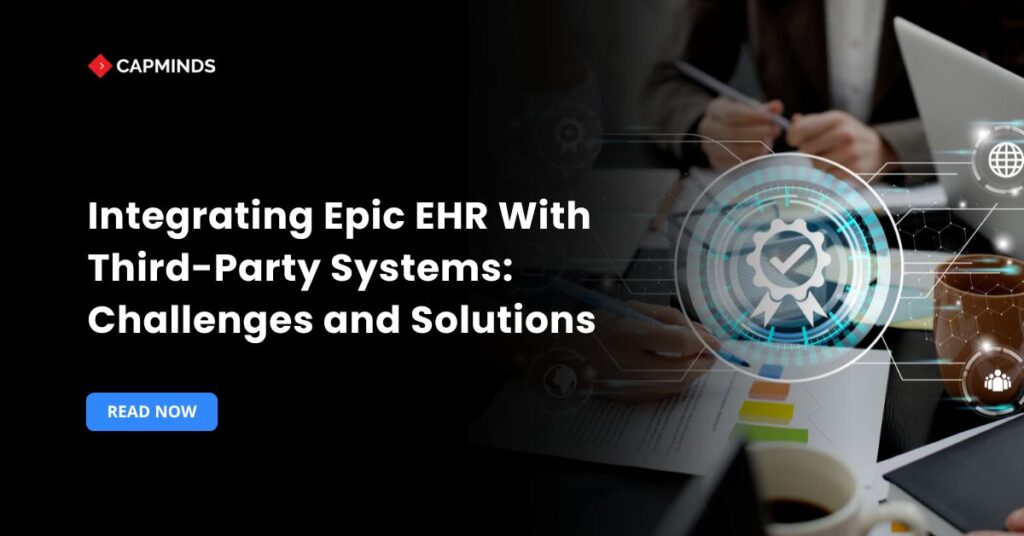Integrating Epic EHR With Third-Party Systems: Challenges and Solutions
Epic EHR has a significant market share in the US. It is commonly utilized in large hospitals and healthcare organizations. The U.S acute care market growth of Epic is 39%. Epic holds the largest market share of 28% among EHR vendors in the U.S.
Though it has various benefits, it also has some challenges while integrating with third-party systems. In this blog, you’ll know about the challenges and solutions to solve them.
What is Epic EHR?
Epic EHR is a cloud-oriented platform ideal for extensive practices and healthcare institutions. It has different functions which includes appointment scheduling, medical billing and analytics.
- Epic has built-in templates for different specialties and clinical documentation.
- Manages patient scheduling, billing, and insurance claims. It has tools for clinical decision support.
- It supports telehealth and remote monitoring. Security measures are provided to protect patient information and prevent data breaches.
- Epic provides seamless data transfer among healthcare systems and organizations, along with modules tailored to specific specialties.
- Integrating with other systems, which include LIMS, pharmacy systems, and other healthcare applications.
Benefits of Epic Integration Services
1. Seamless Data Exchange
Epic EHR allows organizations to exchange data smoothly. Healthcare organizations can experience real-time data synchronization and ensure that patient information is updated across the different systems. This also enhances patient care coordination, efficiency, and a proper healthcare system.
2. Interoperability Regulations
Epic EHR manages data transfer to multiple healthcare systems. This solves the data silos and exchanges patient information effectively. Integrating Epic with third-party systems, such as labs, imaging systems, can promote improved collaboration and communication between providers and systems.
3. Tailored Integration
Epic integration has a customization process to meet the specific needs of the healthcare organization’s workflow. It fits with the existing system and increases the efficiency of data flow. Integrating with data-driven tools provides insights with real-time patient data and identifies trends.
4. Scalability and Efficiency
EHR Integration of Epic offers efficiency and scalability. It enables companies to embrace new technologies and incorporate new systems, guaranteeing lasting scalability. It simplifies medical billing, automates processes, and decreases mistakes, resulting in cost effectiveness.
5. Security and Compliance
Epic EHR implements security protocols that guarantee adherence to HIPAA regulations and data standards. It utilizes data encryption protocols while interfacing with external systems, enhancing data security and privacy.
Related: Epic vs Cerner: A Comprehensive Comparison for Healthcare Providers
Challenges in Merging Epic with Third-Party Systems
1. Data Standardization
Epic uses different data formats, while third-party apps may use different formats for data exchange. Different usage of data formats can break the data flow process and increase the errors. Providers may use different medical codes for the same condition, which leads to data interpretation issues.
2. System Compatibility
Legacy systems use outdated formats and may lack modern API capabilities, which makes the integration challenging with the Epic EHR. It requires high costs for upgrading or replacing legacy systems and is time-consuming.
3. Challenges in Data Migration
While integrating Epic EHR with third-party systems, it encounters synchronization errors, causing data inconsistencies. It includes old patient records, missing information that affects data accuracy. Mapping data between Epic and FHIR standards is a complex and time-intensive process.
4. Compliance Risks
Integrating Epic EHR with third-party applications can expose patient data and make the system vulnerable. This can lead to HIPAA violations and security breaches. The system needs to be re-evaluated due to existing security practices to ensure compliance.
5. Integration Costs
Implementing integrated systems can be costly, particularly for small healthcare providers. Resource allocation requires financial investments and which are important for integration.
Related: How To Customize Epic Hospital Software: A Beginner’s Guide
Solutions for Integrating Epic EHR with Third-Party Systems
1. Regulatory Compliance
Security and compliance risks should be implemented with end-to-end encryption, MS, and role-based access controls to protect patient data. Regular security audits help to identify potential threats. Ensure compliance with HIPAA, HL7 FHIR, and other data standards to enhance data security and compliance.
2. Cost and Resource Allocation
To optimize costs, organizations should adopt a phased implementation that prioritizes critical integrations, enabling efficient expense management. Cloud-based solutions reduce physical costs such as hardware, infrastructure while pre-built APIs and data standards minimize development efforts. Explore grants to reduce financial burdens associated with integration.
3. Data Synchronization
Errors in synchronization and migration risks of Epic EHR should implement validation, quality checks before data transfer. Real-time synchronization tools such as FHIR ensure data consistency across systems, utilizing tools that facilitate the mapping and transformation of data between different formats.
4. Legacy System
Legacy systems can use middleware to bridge the gap between legacy systems and Epic EHR, translating data into compatible formats. Healthcare providers can implement digital phased upgrades. It enables them to progressively modernize outdated systems to FHIR-compatible platforms to reduce disruption.
5. Performance Issues
Cloud infrastructure maximizes speed through workload balancing. It offers flexible storage options that maintain the system’s performance. Employing features of Epic EHR, like cloud-based API, aids organizations in improving their functionalities..
CapMinds EHR/EMR Customization & Integration Service
CapMinds offers a comprehensive solution that can help streamline workflow for healthcare practices that use EHR/EMR systems.
We are a group of professional experts with years of experience in the field. CapMinds’ customizable solution can help to solve the common challenges associated with your EHR/EMR system.
- CapMinds can customize the Interface and workflows in your EHR/EMR to simplify navigation and resonate with your healthcare practice.
- Our solution includes building customized accounting and financial reports tailored to your healthcare practice needs.
- We also excel in RCM, Medical Billing, and collections for practice-based physician groups. Our service includes medical coding, claim tracking, denial management, online payments, and financial reporting.
- Our specialists provide EHR/EMR credentialing service that helps you to submit claims quickly, boost revenue, and avoid productivity losses.
- We can guide you through the entire onboarding process and provide a customized EHR/EMR solution to streamline your healthcare practice workflow.
- Our EHR/EMR integration solution includes integrating third-party tools and apps with your EHR/EMR.
Whether you want to experience the full capabilities of EHR/EMR or a customized solution tailored to your specialty healthcare practice needs, CapMinds is the best cost-effective choice.
Contact us and unlock the full potential of your EHR/EMR system with the help of CapMinds’ customization and integration solution




